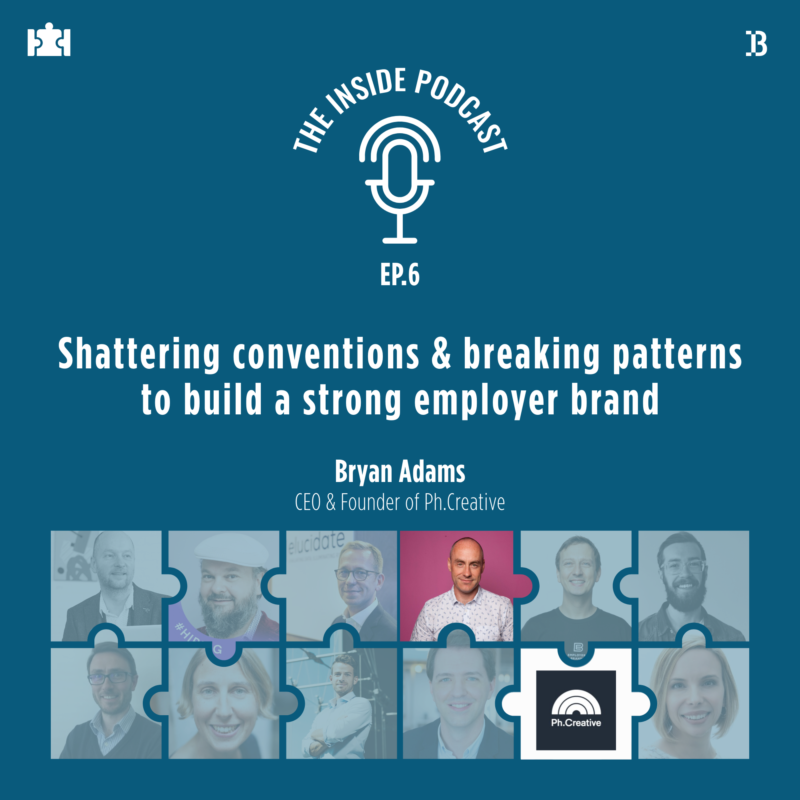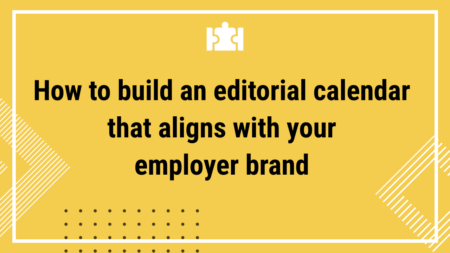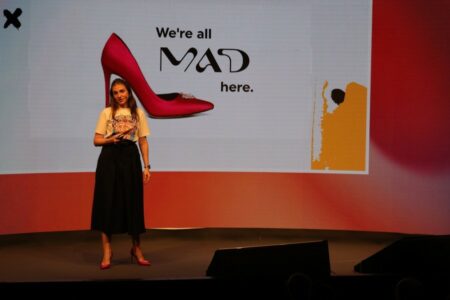Hi, my name is Georgiana. I am the CEO and founder of Beaglecat, and soon you will be listening to Employer Branding: The Inside Podcast. In this podcast, I regularly talk to employer branding managers and acquisition managers, and human resources managers in tech companies in Germany, Romania, and the US. For more content on employer branding-related themes, go to employerbranding.tech or beaglecat.com. Stay tuned!
Overview
In the 6th episode of #EmployerBranding: The Inside Podcast (season 6), we had the chance to speak with Bryan Adams, CEO and founder of Ph.Creative, recognized as one of the leading employer brand agencies in the world. We talked about predictions, breaking patterns, overcoming EVP challenges, and how authenticity is the way to build a strong employer brand.
What you’ll learn by listening
- The challenges associated with building an authentic EVP
- Shattering conventions: unifying a corporate brand with the employer brand
- Guidelines to winning the war for talent: where does authenticity fit in?
- Hiring for skills vs hiring for personality
- Job descriptions do’s and don’ts
- Building original Career Pages & common mistakes to avoid
- Breaking the pattern during a job interview
- Predictions for 2023: what’s next for employer branding?
About PhCreative
Effective employer branding means happy candidates and happy teams, and ultimately that means happy customers. Ph.Creative believes that happiness is the single most important element of modern-day business strategy. Dedicated to better candidate experience, Ph.Creative brings clarity, focus, and diversity to their clients’ talent attraction activities, ensuring they discover the best people for their businesses, worldwide.
“If companies and people know the best fit for themselves, then matching them up is easy. And if companies and people live up to their promise they should always be happy, together. Agreed?”
Podcast link – Enjoy listening on Spotify!
Podcast transcription – Employer Branding T.I.P S06Ep.06
Georgiana:
Hi, everyone, Georgiana here with a new episode of Employer Branding: The Inside Podcast. It’s been a long time since I recorded an episode because I’m working a full-time job now, which means actually have four jobs in total. But I’m super excited to be doing this.
Again, I’m especially excited to be speaking to someone who’s been very inspirational to me and employer branding. Since I took up the discipline, so to say since I started working on employer branding-related projects. His name is Bryan Adams, he is the founder of Ph.Creative. And I think Ph.Creative is one of the most reputable companies when it comes to employer branding out there. I will give him the opportunity to introduce himself in just a little bit.
I just have to say, Brian, once again, I’m super excited to be meeting you. And I can’t wait for you to share everything you know about employer branding. Welcome to this episode. And thanks once again for doing it.
Bryan Adams:
No, it’s my pleasure. And I’m glad to hear that you’re back with the show. And congratulations on juggling the four jobs. That’s insane. But we’re all very lucky that you make time to do this. So thank you.
Georgiana:
Thank you so much. Brian, you’ve been doing Ph.Creative, and implicitly employer branding for about 18 years. You started in the UK. I gather that from the accent. But now you’re located in California. So can you please tell me a little bit about how this all started? And how have you changed locations? Did you offer employer branding from the very beginning?
Bryan Adams:
18 years ago we started as a general marketing company. We did print, we did digital, we built websites, we did a whole host of things. And we had no point of difference. We weren’t anything particularly special, we thought we were but you know, we struggled as a small business. We were working with all sorts of local small companies. And a few years in, we started working with a couple of brands to do some recruitment marketing, which was new to us.
But we identified a little bit of a trend. We started to focus before too long, and we decided, hey, this is something special, it’s different. It gives us a point of difference. We like working with HR people because they return our calls. And they’re super nice. So the specialists of niching of the business stemmed a few years in actually. We’re super glad that we did do it because it allowed us to build up some expertise in an emerging field, and contribute to an industry and it’s definitely the reason I attribute to working with some of the world’s biggest brands today.
Georgiana:
Yes, indeed. I saw that on your LinkedIn profile. And I think maybe this is also one of the reasons why you were able to gather all of your knowledge into the “Give & Get Employer Branding” book, which I read about a year ago; or I think during COVID, actually. And I was wondering, why would you say companies still shy away from creating and maintaining an authentic EVP? You speak a lot about that in the book, too. But what has practice shown you so far?
Bryan Adams:
Yeah, so I think a lot of times organizations will focus on employer brand out of necessity or a need. Usually, there’s something on fire, like people leaving the company too quickly. Or there’s a real challenge in terms of how to attract the talent they need to grow. It’s sort of not yet made its way to sort of conventional business strategy books and so on and so forth. Because I think it’s new, relatively speaking. I don’t think it’s organizations shy away from it. I think there are still some organizations that are a little bit naive to the fact that you can do more and be more strategic and approach recruitment, retention, and culture in a different way.
Georgiana:
Actually, I have a more strategic question so to say, following up on your reply. Before writing “Give & Get: Employer Branding” your company and you delivered the first ever employer brand to be adopted as a main corporate brand in a fortune 500 Company; Magellan Health is the name of it, and you have it on your LinkedIn profile stated as well. And you say that it was delivered in less than 100 days for 100k, shattering conventions of time, budget, and approach. My question is, how did you manage such an effort? And what actually led the company to actually accept the unification of the employer brand and the corporate brand? Because this is really, really unusual.
Bryan Adams:
Yes. At the time, that health company was struggling to find any point of difference from a talent perspective, but probably also from a marketing perspective. I think that’s fair to say. But actually, that was our first US client, moving from the US. And it’s what really helped us establish a firm footing in the US. And our client partner, leading the employer brand on the Magellan side was Charlotte Marshall, who turned out to be my co-author of “Give & Get: Employer Branding”.
And she was incredibly experienced. She had experienced building, I think it was five employer brands before we worked together, but she’d done it the conventional way. So she was super intrigued by our approach, because it was different, and she recognized the value in it. But what it meant from a working relationship perspective is we were both organized. And we were both able to move quickly. And we saw this as the opportunity to prove our methodology versus convention. So the planets aligned, and all the pieces fell into the right place. And we were able to produce fantastic work in record time. And it really made an impact on the organization. But it went on to make an impact on the industry as well, I’m glad to say.
Georgiana:
And has it happened again, since?
Bryan Adams:
Well, I always say that it’s possible because we’ve done it before. You know, there were a few tears before bedtime a number of times when we do that fast. I’m not in any rush. But it’s almost like breaking the four-minute mile. Everything’s more possible once it’s been done. And really, the reason we talked about that case study, obviously, it’s the sort of the first differentiator from the given get approach.
But the convention was, you know, it takes 12-18 months to build an employer brand before that. And by that time, your organization could have changed, things move on, and research gets stale and old. So 100 days is super quick. It’s not necessary to do it that fast. But the sooner you do it, the more authentic it is. And the easier it is to launch with momentum and get adoption. And get a return on investment in the same financial year, which businesses seem to like. But the sooner you launch, the sooner you can test it, and then start working on refining it and making sure it’s always reflecting the culture and the employee experience.
Georgiana:
And you were mentioning authenticity a few moments ago. I’m wondering, is the authenticity the only way to win the war for talent? Or would you say is the most qualified one?
Bryan Adams:
I think everybody will agree that if you build a fantastic employer brand, that’s an illusion and doesn’t represent the truth about what you will find on the inside. It might be incredibly powerful to attract an unfair share of talent to your organization. But keeping that talent immediately becomes a problem. Once they find out their expectations aren’t being met. So what we find is, not only is it the most ethical and fair way to attract talent, because you’re better setting expectations. It’s also more powerful if you lean into the harsh realities and adversities and tell the full truth of what you might find.
Because this isn’t just about being more authentic about the negative aspects of an employee experience. It’s also having the opportunity to tell the narrative in the context of why some of those harsh realities might exist. And typically what we find is, if there is adversity, or challenge or specific capabilities required to thrive in an organization, it’s also the greatest source of a sense of achievement, pride, and passion. Because if you can thrive in those circumstances, and move your career forward or grow as a person, then that feels good. So a lot of the time the value has been left on the table by ignoring that stuff.
Georgiana:
Now we’re moving a little bit to the talent acquisition realm if I can say so. Which one would you choose and why? Hiring for skills or hiring for personality? Or both, maybe?
Bryan Adams:
That’s an interesting question. And I think I’m not sure about personality, I would probably say capability because it includes resilience. It includes personality, but actually, it’s more inclusive. So I think that would be my preference: capability, a culture match, and a culture add. The truth about this is people need to be able to also do their jobs. So there is a balance, there’s a hygiene bar, to both of these things, I think getting a balance and being super clear about what it takes to thrive on both sides is really important. But of course, skills can be taught. So I tend to lean towards the capability and culture side of the equation.
Georgiana:
And, on the same note, because we, at Evolution, struggle with job descriptions, and all the companies that I’ve worked with, struggle with job ads and writing those job ads that are a bit different and more authentic than most. Do you have a tip for writing a powerful job description? Or if you were to just state one tip that people could apply starting tomorrow? What would that be?
Bryan Adams:
Yeah, so in the book, we give away a formula for job descriptions. We talk about starting with empathy, leading with trying to connect the role of this vacant job with the higher purpose of the organization. If you can sell a sense of purpose, impact and belonging right up top with the headline; usually, that could be a question like, “Would you like to impact or do something that the organization stands for?” That’s usually a good way to start when the hearts and minds of the beginning and then immediately create some curiosity and some surprise about the role and draw them into the insights of the specifics that are required, and have a strong call to action at the end.
And I think social proof, we’re in an age now where people trust people more than brands. So I think hearing from employees, so they can describe the team, describe the work. I think that’s an important part of the mix as well these days. And it’s not easy, certainly at scale. But you know, if you think Amazon, sometimes split test product pages, and they can be 8 to 12 feet long, in terms of how much content, how many reviews, how many product descriptions they have. This is the sharp end of e-commerce and the job description on a careers website is exactly the same. So why should it be easy, this is competitive. So it’s about trying to get all of those ingredients in and take candidates on a journey where they can make an informed decision. And, you know, we are trying to sell the organization, as long as we do it with the truth. And we give a well-rounded view of what you will find, you know, the tough stuff, as well as the really good stuff. And the link between them, I think that’s the ideal approach.
Georgiana:
Yeah. Which is, sadly easier said than done. What mistakes have you seen companies do when it comes to Career Pages? Because they tend to look similar? Identical almost.
Bryan Adams:
I guess the biggest sin really is just allowing whatever is in your ATS, your applicant tracking system, to just squirt on the page and hope that people are going to apply for jobs based on what they read. I mean, we’ve seen some horrific examples of copy that really isn’t fit to be shown to candidates. So not taking care of the job ads, I guess the first thing. The second thing is not using the employer brand to its full extent once you’ve developed it.
Because I think it’s a huge mess if you’re not activating with strategy and scale and using everything available to you. And then I guess the final thing really is thinking that you need to brag about your company and brag about the role and just talk about strengths, benefits and opportunities and not include the good stuff about, you know why you’ll be challenged and what it’s like on the worst day as well as the best day?
Georgiana:
Your work with big companies, companies such as Apple or American Airlines, for example, but I’m thinking that you’ve worked with startups as well. Are there any common elements between the two? Are there mistakes that both parties make?
Bryan Adams:
Yeah, so I mean, at the end of the day, we’re just talking about people trying to connect with people. So all of the principles apply, whether you’re an organization of one or an organization of 1 million. Of course, it’s easier to design, the culture and the employee experience that you want, rather than trying to change something or manage something once it’s scaled.
So we love working with startups that are more aspirational and have an opportunity to be more agile, empathetic, and compassionate to what their people actually want. You know, so that can be fun. Usually, they’re the brave creative ones as well, so we get to do more fun stuff. But a lot of the principles, all of the principles, and the approach are exactly the same. I guess the mistakes that we see in the industry is the sort of just leading with the strengths, benefits, and opportunities.
And thinking that you need to be the shiniest, most attractive in the marketplace and try and be attracted to everybody, rather than understanding the audience that is ideal to you. The mistakes that we see don’t really correlate to how a larger organization is. If anything, it’s easier, and it can be used as a competitive advantage for small organizations to tell a more authentic inspirational story than their large competitors.
Georgiana:
Now coming back a little bit to the talent acquisition part of during the job interview. Which party should be the first to break up the pattern? And just be honest.
Bryan Adams:
What a great question. I think, by and large, it’s the brand’s responsibility to own the narrative, and be clear with the expectations of the candidate. And the candidate is usually in a situation of high stress. They’re nervous trying to make a great impression, and so on, and so forth. So the job of the organization is to settle those names and be clear with what’s on offer. So I would say, by and large, it’s the responsibility of the brand to break that cycle and be clear about what you might expect.
And, I mean, in our interviews, we talk about the five reasons not to join Ph.Creative, so people really get a good idea. Essentially, if you’re not providing enough information for a candidate to make an informed decision about the reality of a role, then I don’t think you know, we’ve done our job as a brand. The exception to this is seen in very senior roles. I would expect a vice president or a senior director to turn up on an interview and answer questions, but then clearly break the pattern with yet okay, I’ve read all of that stuff. What’s it really like? And I think, with more senior positions, you have the opportunity to assert yourself and to really dig. Regardless though, at some point in the interview, and usually it’s at the end, do you have any questions for us? I think it makes a great first impression if you are curious.
And you do have some questions that say, Hey, look, you know, everything sounds great. What are we missing? What haven’t we talked about? What am I going to find on my worst day? You know, if there was a reason for people to leave a predominant reason for people to leave. I think if you’ve got the confidence and clarity to ask that question, in an interview, you go into quickly become a standout candidate. You know, because it’s smart. This is a really important decision, a career decision next to getting married or moving house or having children this is this is where up there with the big life decisions, you know, so why not ask those questions?
Georgiana:
Yeah, I think those are excellent questions. Actually, now as we’re approaching the end of this discussion, I’m wondering, are there things that you predict for 2023 when it comes to employer branding. I’ll be asking this question to all of my guests by the end of the year just to see if we can draw some unanimous conclusions.
Bryan Adams:
I don’t know whether this is going to happen in 2023. But I think what we will start to see is organizations become a lot more strategic and longer-term with how they protect their reputation as an employer. And I think what that means is, more organizations are going to realize that they need to invest in the alumni community. When you see Twitter, and matter making 1000s and 1000s of layoffs, Netflix before them and lots of other tech companies. A big component of protecting your reputation over the long term is how you treat people when you’re off boarding, and how you engage with them and retain some element of the community after they’ve left.
So I think we’ll start seeing the industry focus a little bit more on the alumni community, whether that happens next year, or a couple of years down the line, I don’t know. But smart organizations are already thinking about it. And if you think about that, the alumni community is the community that is guaranteed to grow. Usually, it means over time, it’s going to increase in seniority and influence. So having a seemingly neutral community, and championing your brand is a great thing.
And it’s a fantastic way to protect your reputation over the long haul. So I think that’s what we’re going to see out. And then of course, more immediately in 2023, all tech companies are shedding their tech talent. And then the rest of the world, the rest of the organizations that aren’t pure tech organizations are still in the early stages of digital transformation. So we’re gonna say a huge transfer of power, and talent dispersed into lots of other sectors and industries.
And when it comes to the cyclical 10 of the economy, when tech companies need to hire that tech talent back to find that their employer brand is extremely important because gone are the days where you can demand a developer works long hours or comes into the office, or, you know, works under the conditions of a conventional tech company. So we’re gonna see organizations grow up and mature very quickly. And that probably will happen towards the end of next year.
Georgiana:
And you were mentioning briefly how tech companies are doing layoffs. And I’m shocked and angry at what’s happening around me here in Berlin. And I see it happening in Romania, where everyone’s talking about a hiring freeze, or then cautious hiring. And I’m wondering, how did we get here? This is unbelievable. You guys were hiring like crazy six months ago, four months ago, and sometimes even two months ago. And now what’s going on? What’s the plausible explanation for that other one, for example, in VCs, I mean, companies backed by VCs, just hired to hire and not because they really needed the people.
Bryan Adams:
Well, you know, when the economy is going up, and up, and up and up, and your competitors around, you are growing, there’s a land grab for talent. People are making choices, you’re losing your best talent, then, you know, companies, leaders of these companies make short-sighted decisions, because there is opportunity tomorrow. What we know is the economy is cyclical. And you know, you can’t just keep going up forever. So it’s going to come down. And that’s what we’re experiencing. So there’s been some short-sighted decisions here. And organizations are paying the price. When you see companies like Apple, and they’re really secure, obviously, very cash positive, but they’ll be able to retain their talent through leaner periods and down downturns, by and large. Organizations that understand the value of talent will fight to keep hold of the talent they’ve got as much as possible because as sure as we are of companies letting people go, it’s not going to be too long before they try to hire them back again.
Georgiana :
We’ve seen it happen before, right? Two years ago.
Bryan Adams:
It’s just the way of the economy. The difference is organizations are for the first time in 100 years are learning that people really are the only competitive advantage in business. So they’re becoming more empathetic and compassionate and strategically empathetic and compassionate with how they treat people. But the lesson here is the tech industry has been far too aggressive. And they’re paying the price now and suffer the consequences or risk to the reputation. When Meta needs to hire again, in the not-too-distant future, there will be 11,000 people out there that aren’t going to be quick to apply for that role. But I will say that Mark Zuckerberg let them go with grace and professionalism, much better than Elon Musk, you know, so there’s more damage control happening in some companies compared to others.
Georgiana:
Would you say that’s better employer branding, in the long run?
Bryan Adams:
It definitely is, without a shadow of a doubt, you know, demonstrating that you’re at least empathetic and you’re considering how people feel with dignity and respect. It’s an important factor. And going back to the alumni conversation a little bit earlier. There hasn’t really been any sort of backlash from Meta; there haven’t been any angry employees. Everybody sort of welcomed it with grace and dignity and respect, even though Meta laid off three times more people than at Twitter if you look at how Elon Musk did it. That’s a really good lesson and an example of how not to do it.
Georgiana:
Exactly. Yeah. That’s true. Great, well, this was it. Thank you once again for agreeing to participate and to share your knowledge. And good luck with everything.
Bryan Adams:
Thanks so much. Really enjoyed talking to you and good luck with the new revitalized series. I’ll be listening and cheering you on. Thank you.






